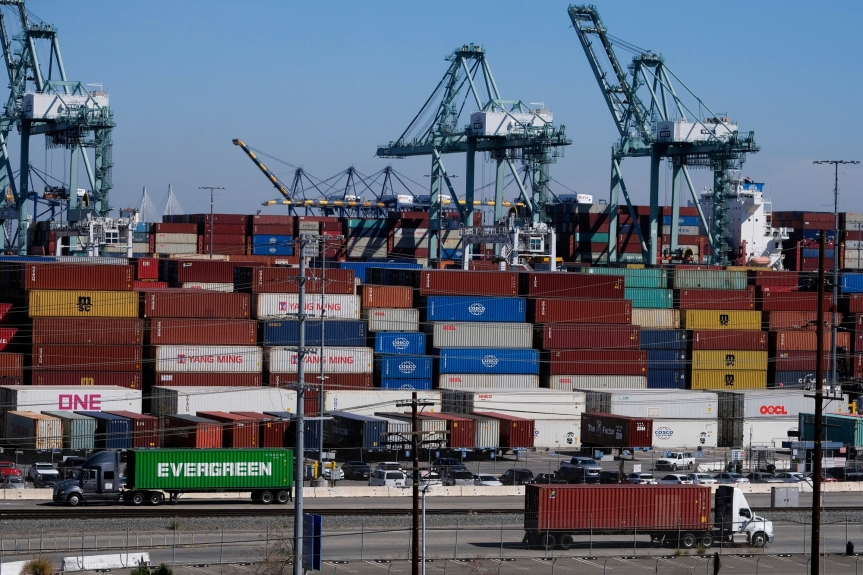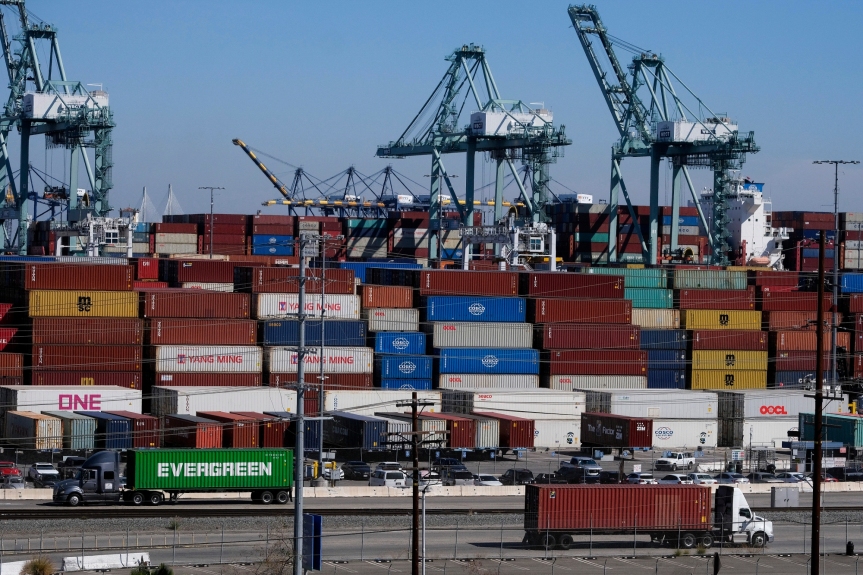Cargo continues flooding into Port of LA with 2022 looking to be a repeat performance

As 2021 comes to a close, efforts are underway on multiple fronts to ease the supply chain issues that saw massive ship backups at the ports of Los Angeles and Long Beach.

But while the backups aren’t as visible because of a new queuing system, don’t look for a dramatic easing of the supply chain crunch in the new year, said Port of LA Executive Director Gene Seroka in remarks made on Wednesday, Dec. 15.
Providing his 2021 wrap-up thoughts, along with cargo numbers from November, Seroka enumerated several advances that have been seen: productivity levels are up, cargo dwell times are down.
But, he added: “We’ve got a long way to go and no one is declaring victory.”
Among looming challenges, Seroka said, is providing enough chassis so truck dwell times can be further cut.
As the calendar year nears its end, cargo numbers from January to November stand at about 9.8 million container units, which is 18.7% higher than the previous record for that time period set in 2018 — and puts the nation’s busiest port on track for 10.7 million to 10.8 million twenty-foot equivalent units for the calendar year.
And Seroka, in his monthly virtual news conference, said he foresees that pace continuing through 2022.
With the peak holiday season shipments now done, the rush already is on to beat shipment deadlines before what will be an early Lunar New Year, causing factories in China to close in early February.
After that, Seroka said, U.S. retailers have indicated they’d spend the second quarter of 2022 replenishing their stock.
From there, he said, “we will pivot into an earlier-than-normal peak season” at the end of next year.
While data still needs to be finalized, November cargo figures stand at about 812,000 incoming TEUs, Seroka said, adding that is a 9% decline from November 2020 when the cargo surge was in its early peak.
Some of the container vessels now seen, Seroka said, are smaller ships carrying fewer TEUs.
Store inventories stand only about 1% below where they were 12 months ago, Seroka said, and warehouse inventories are up about 2% compared to the same time last year.
“While there is still much more we need to improve,” Seroka said, “goods are making their way into the hands of consumers.”
A new queuing system for ships now allows vessels to “transit a bit slower and put in a request for labor as they depart Asia,” Seroka said, rather than speeding across the ocean and then jostling to reserve a berth time while anchoring directly offshore.
The new arrangement, he said, is not a way to “hide” or disguise how many vessels are waiting at any given time. The system is still new, he said, but the numbers are now being fully tabulated and posted on the port’s website.
The protocol now provides more ship safety, especially during high wind events, and the change is also seen as a way to cut pollution in port-side communities.
“Most agree it was a smart decision,” Seroka said of the plan formulated by the Pacific Maritime Association, Pacific Merchant Shipping Association and the Marine Exchange of Southern California.
As of Wednesday, he said, 97 ships were either at anchor, drifting or “slow steaming” toward the San Pedro Bay. Forty-five of those were headed for the Port of Los Angeles, he said, and 52 were going to the Port of Long Beach.
Rail dwell time — the amount of time cargo waits on docks to be picked up and taken to its ultimate destination — now is down from a peak of 13.5 days during summer, Seroka said, to two days currently.
“That’s the lowest it’s been since pre-COVID times,” he said.
Truck dwell time, he said, could be better, but it also has declined from a peak of 11 days to six days.
But problems continue with appointments — now at about 53% — not being picked up by trucking companies or drivers to return empties and pick up loaded cargo containers, Seroka said.
Exports continue to plunge, which is requiring its own focus, the director said.
And empty containers piling up also are still a problem but progress has been made on that front, he said.
There are “71,000 empties (that) exist and we are imploring shipping companies to bring in more and larger sweeper vessels” to remove them, Seroka said. “We’ve created several near-dock depots on Terminal Island so empties can be returned to mid-point locations to better triangulate the flow of the trucks and move cargo out faster.”
The 2021 holiday shopping season, Seroka added, has been “longer than any we’ve seen in the past.”
After urging from the ports, retailers began ordering holiday shipments in the summer to make sure products would be on the shelves in time.
The overall supply chain issues, he said, remain myriad and complex.
“I was talking to a reporter the other day,” Seroka said. “I wasn’t trying to be flippant, but I said it’s almost like a game of Whac-A-Mole.
“There’s a lot on our plate every day,” he said.
Beyond the port borders are bottlenecks being seen elsewhere along the supply chain, including at the nation’s top 20 trucking bottlenecks, two of which are in California, according to a study released this week by TRIP, a national transportation research nonprofit based in Washington, D.C.
The California trucking bottlenecks making the top 20 are the 10 Freeway at the 15 Freeway in San Bernardino, ranking No. 10 overall, and the 60 Freeway at the 57 Freeway in Los Angeles County, coming in at No. 11.
Most of the warehouses that receive and store port cargo are in the Inland Empire.
Freight movement fell 10% by April 2020, an example of the resilience of the supply chain and the country’s reliance on freight movement, according to the report.
National freight movement, which includes for-hire trucking, freight railroad services, inland waterway traffic, pipeline movements and air freight, peaked in August 2019. It bottomed out in April 2020 and by September 2021, it rebounded to within 2% of September 2019.

